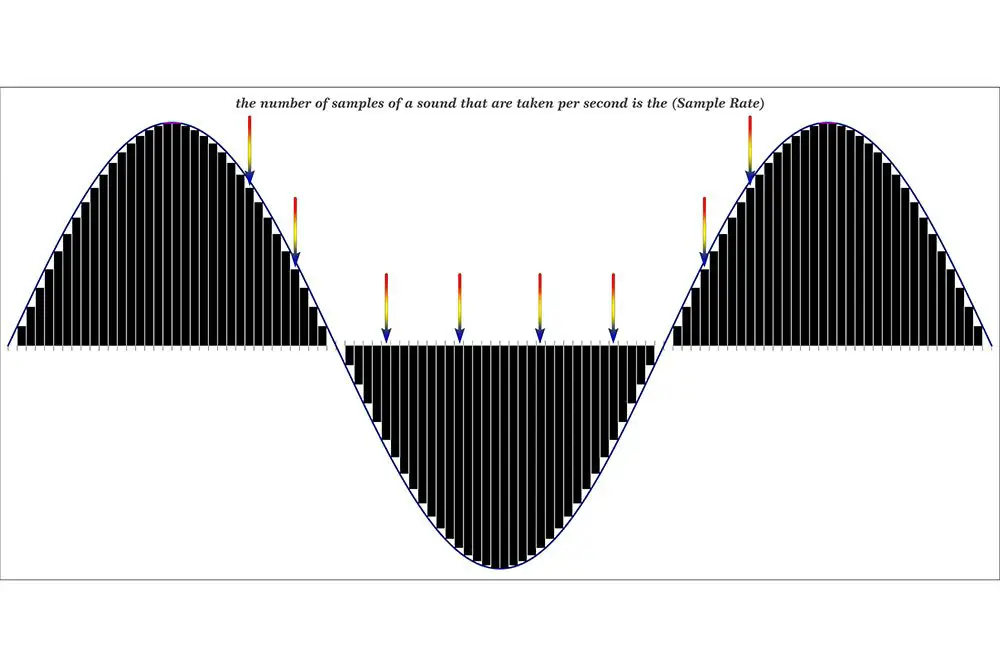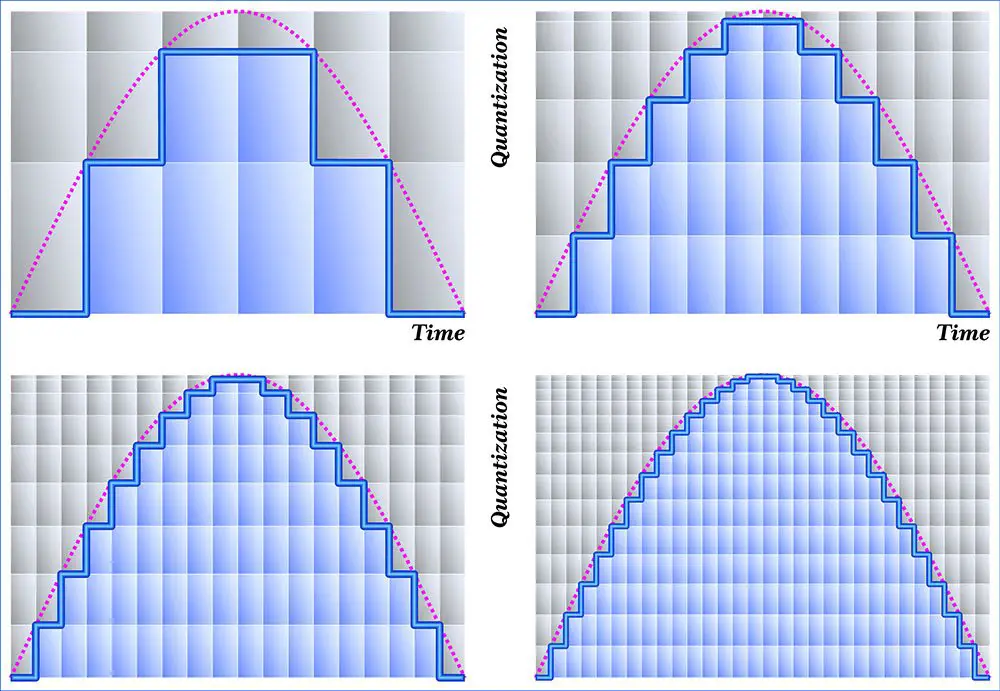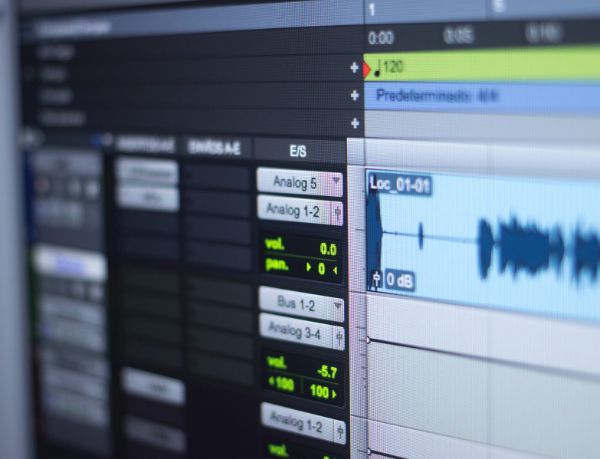From the microphone brand, you should be recording with to the software you should use for editing; many topics are debated in audio recording.
As you may well be aware, one of the most hotly debated subjects is sample rate vs. bit rate.

Trying to work out the difference between the two isn’t helped by the technical jargon that surrounds them, either. That’s why we decided to make things a bit clearer.
So, whether you’re new to audio recording or want a clearer explanation of what sample rate and bit rate are, what separates them, and how each has an impact on audio quality, then keep reading!
Table of Contents
How is Sound Digitally Recorded?
Before we can understand the difference between sample rate and bit rate, it’s important to understand exactly how sound is digitally recorded.
When sound is fed into a microphone, a pressure wave is created that flows through the air. This pressure wave then creates a vibration in the microphone’s diaphragm located in the mic’s head.
This vibration works with the microphone’s transducers to create an electrical signal that varies continuously with the pressure waves.
This variation is where the term ‘analog’ comes from. Many different materials have been used to store analog signals throughout the years, including vinyl, wax, and magnets.
Eventually, digital records were introduced, and they became the standard for audio recording.
What is Sample Rate?
So, where does the sample rate come into play during the audio recording process? The term ‘sample rate’ refers to the frequency of the wave produced by the sound you’re recording.
Think about old animated films that were produced by flicking through the pages of a sketchbook. The fast movement of these still images gave the illusion that the character was moving. This was known as ‘frame rate.’
In a digital audio recording, the sample rate works in the same way that frame rate does for a video. The more sound gathered over a short period, the more accurately the sound is reproduced.
The sample rate for audio recording is typically 44.1kHz. You might think this is quite a high frequency. However, this is because the human ear can only hear frequencies up to 20kHz.
Working with the ‘Nyquist Theorem,’ to prevent any loss of information when these audio samples are produced, a sample rate of at least twice the highest frequency.
Put simply, a sample rate produced at 44.1KhZ allows for accurate reproduction of frequencies at 22kHz, which is the perfect level of frequency for the human ear.
Bit Depth
Before we start looking at bit rate, we need to look at bit depth. This is where we can start to understand the term ‘bits’ in greater detail.
Computers store information in 1s and 0s and these binary values are referred to as ‘bits.’
When an audio signal is sampled, the gathered information is stored in bits, and this is where bit depth becomes important.

To put it into the simplest terms possible, bit depth determines how much information can be stored and the recording quality.
So, for example, an audio sample with a 24-bit depth will be capable of storing more nuances and, in turn, producing a more accurate representation than a 16-bit depth.
Below, you can see the maximum number of values each bit depth can store:
- 16-bit: Can store up to 65,536 levels of information
- 24-bit: Can store up to 16,777 216 levels of information.
So, as you can see, there is a vast difference between the two. But does this mean that you should always record in 24-bit?
Yes, you absolutely should. 24-bit is currently the gold standard for producing super high-quality audio.
As technology continues to evolve, this will probably change, and some manufacturers are already creating 32-bit depth capabilities.
However, a word of warning here would be that if you intend for your listeners to stream your audio, then a 24-bit depth should be approached with a little more caution.
This is because the increased file size can potentially drain their internet bandwidth.
It really all comes down to what you want to do with your audio recording. If you have unlimited storage space and want to manipulate your recording, then 24-bit is the way forward.
But, if you intend to make your music or podcast available on a streaming service, then 16-bit could be the better option.
It’ll certainly result in fewer complaints from your listeners over the effect on their bandwidth!
What is Bit Rate?
Bit rate basically works in the same way as sample rate, but instead of measuring samples, it’s the number of ‘bits’ that are being calculated over the period of time you’re recording.
However, the bit rate is more commonly used in a streaming/playback context than in a recording situation.
Generally speaking, a higher bit rate is associated with a higher quality of audio. This is because each ‘bit’ inside an audio file captures a piece of data that can reproduce the original sound.

Put simply, the more ‘bits’ there are in one single unit of time (second, minute, etc.), the closer you’ll be to recreating the original continuously variable sound wave being produced by your microphone’s diaphragm and transducers.
There is a slight downside when it comes to the bit rate, though. The higher the bit rate is, the larger your audio file will be.
This can pose a problem in editing and mixing, not to mention the amount of storage space each file will eat up.
Since bit rate is most commonly used with streaming platforms such as Apple Music or Spotify, a large file can also affect bandwidth.
But what bitrate is the best for recording? Typically the default lands in the 128kbps – 192kbps area.
Anywhere within this range will give you an audio recording that the human ear would find difficult to distinguish from the original recording.
Does High Bit Rate Offer a Superior Listening Experience?
To look at this, let’s first create an example. A typical five-minute, 16-bit audio recording will typically have a file size of 50 megabytes or 1.4 megabytes per second (uncompressed).
Thinking about an hour-long podcast episode, this would take up a fair amount of bandwidth.
Briefly traveling back in time to the world before streaming services were available, the MP3 codec was developed to solve storage issue problems and to make it possible to compress CD-quality audio without a loss of audio quality from the original recording.
This was typically 128kbps or 192kbps.
However, in the modern age of streaming, the issue needs to be dealt with slightly differently.
The main reason is that streaming services are open source, and they require a high quality relative to the bandwidth required.
The solution came in the form of Ogg Vorbis (Spotify) and AAC (Apple Music).
Both of these compress audio files to function with a 192kbps. As we know, the human ear simply isn’t precise enough to tell the difference from anything above this. Anything higher than this becomes indistinguishable from the original recording.
Suppressing audio files in this way doesn’t come without its consequences, though. Spotify limits the bit rate to 160kbps for desktop listening and just 96kbps for mobile users.
However, this is only applied on the free version, and a premium Spotify subscription brings the bit rate up to 320 kbps on a desktop platform.
Apple also limits the bit rate of audio files to 256kbps. This isn’t really ‘limited’ though, and it barely has any effect on the overall quality of the podcast or song you’re listening to.
While it’s not completely necessary to record at a higher bit rate, it does offer a slightly superior listening experience.
This really only applies if you’re listening to audio through a hi-tech system where you’ll be able to notice the difference in quality.
However, since most people tend to listen to podcasts or music through headphones and keep in mind that the human ear won’t distinguish anything above 192kbps, it’s not something that you need to fret over too much.
Conclusion
Hopefully, the above information helps explain the differences between sample rate and bit rate and touch on bit depth along the way.
If you’re still a little unsure, however, allow us to summarize below:
- Sample rate is the number of audio samples recorded over each unit of time.
- Bit rate is the number of bits that are recorded over each unit of time.
- Bit depth measures how precisely each sample is encoded.
Unlike most of the debates surrounding audio recording, there isn’t a winner between the two.
Instead, sample rate and bit rate should be considered how much ‘clearer’ and audio file sounds based on its encoding process.
Moving forward, knowing the technicalities that surround sample rate, bit rate, and bit depth should make it easier for you to find the right audio formats and appropriate streaming services for your needs.